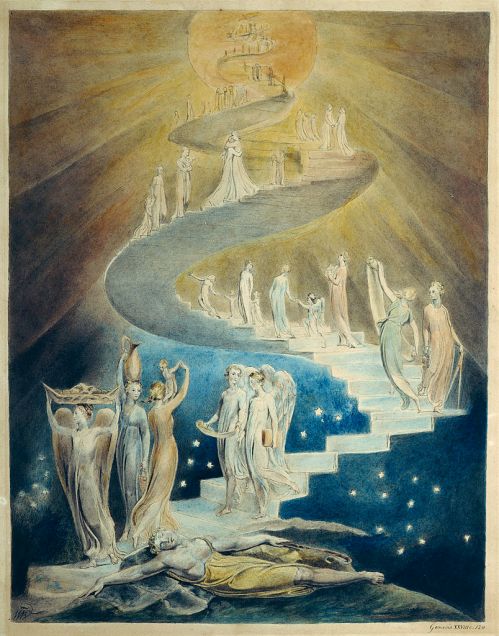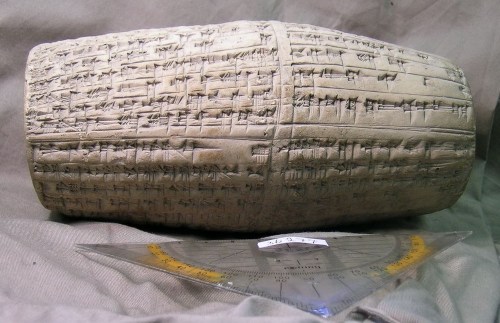Selz: Enoch Derives from 3d Millennium BCE Mesopotamia
” … [He who saw the deep, the] foundation of the country, who knew [the secrets], was wise in everything! …
he saw the secret and uncovered the hidden,
he brought back a message from the antediluvian age.”
From the introduction to the Gilgamesh Epic, A.R. George, The Babylonian Gilgamesh Epic: Introduction, Critical Edition and Cuneiform Texts (2 vols.; Oxford: Oxford University Press, 2003), 1:539.
“The general framework of the “Mesopotamian Background of the Enoch Figure” is quite well established.
Since the initial comparison of Berossos’ account of Mesopotamian antediluvian kings and heroes to the biblical patriarchs a vast literature has evolved that discusses the possible transfer and adaptation of such Mesopotamian topics as ascent to heaven, the flood story, primeval wisdom, dream-vision, divination and astronomy.
I argue in this paper that the respective traditions reach back to a third millennium “origin.”
Enoch, described in Genesis 5:22-25 as great-grandson of Adam, father of Methuselah and great-grand-father of Noah, lived 365 years and “he walked with God: and he was not, for God took him.”

William Blake, Enoch, lithograph, 1807 (four known copies).
William Blake’s only known lithograph illustrating Genesis 5:24, “Enoch walked with God; then was no more, because God took him away.”
This work is in the public domain in the United States, and those countries with a copyright term of life of the author plus 100 years or less.
https://en.wikipedia.org/wiki/Bereshit_(parsha)#/media/File:William_Blake_Enoch_Lithograph_1807.jpg
Enoch became a central figure in early Jewish mystical speculations; 1 Enoch, or the Ethiopic Enoch, is one of the earliest non-biblical texts from the Second Temple period and, at least in part, was originally written in Aramaic as demonstrated by the fragments found among the Dead Sea Scrolls.
(See H.S. Kvanvig, Roots of Apocalyptic: The Mesopotamian Background of the Enoch Figure and the Son of Man (WMANT 61, Neukirchen-Vluyn: Neukirchner, 1988), p. 35: “Astronomy, cosmology, mythical geography, divination . . . are subjects which in a Jewish setting appear for the first time in the Enochic sources, at least in a so extensive form.”)
(J.C. VanderKam, An Introduction to Early Judaism (Grand Rapids: Eerdmans, 2001), pp. 88-94; see also J.J. Collins, The Apocalyptic Imagination: An Introduction to Jewish Apocalyptic Literature (New York: Crossroad, 1992), esp. the chapter on “The Early Enoch Literature,”pp. 43-84.)
(On 1 Enoch see J.T. Milik, The Books of Enoch: Aramaic Fragments of Qumrân Cave 4 (Oxford: Clarendon, 1976) and cf. the review by J.C. Greenfield and M.E. Stone, “The Books of Enoch and the Traditions of Enoch,” Numen 26 (1979): pp. 89-103.
A modern translation of the text is now published by G.W.E. Nickelsburg and J.C. VanderKam, 1 Enoch: A New Translation (Minneapolis: Fortress, 2004).
For the religious-historical framework of the book see J.C. VanderKam and P. Flint, The Meaning of the Dead Sea Scrolls: Their Significance for Understanding the Bible, Judaism, Jesus, and Christianity (San Francisco: HarperSanFrancisco, 2002); cf. also VanderKam, Introduction.

William Blake, Jacob’s Dream, c. 1805 CE. Currently held at the British Museum, London. Commissioned and acquired from William Blake by Thomas Butts.
Also available at the William Blake Archive.
This work is in the public domain in the United States, and those countries with a copyright term of life of the author plus 100 years or less.
https://commons.wikimedia.org/wiki/File:Blake_jacobsladder.jpg
A thorough study of the Enochic literature should, of course, also take into consideration the many references to Enoch in the so-called apocryphal literature. There are presently two recommendable translations: OTP and AOT.)
They prove that the Astronomical Enoch and the Book of the Watchers are among the earliest texts collected in 1 Enoch.
2 Enoch belongs to the Old Slavonic biblical tradition—a tradition that is still very much alive in the popular religion of the Balkans.
(At the time when I finished this article I was not yet able to check The Old Testament Apocrypha in the Slavonic Tradition: Continuity and Diversity (ed. L. DiTommaso and C. Böttrich with the assistance of M. Swoboda; TSAJ 140; Tübingen: Mohr Siebeck, forthcoming 2011).
Indeed, as F. Badalanova Geller was able to demonstrate, there is an oral tradition still alive in contemporary Bulgaria, incorporating various pieces from the Jewish and apocryphal traditions, which has also considerable impact on orthodox iconography.
(F. Badalanova Geller, “Cultural Transfer and Text Transmission: The Case of the Enoch Apocryphic Tradition” (lecture delivered at the Conference “Multilingualism in Central Asia, Near and Middle East from Antiquity to Early Modern Times” at the Center for Studies in Asian Cultures and Social Anthropology at the Austrian Academy of Sciences, Vienna, 2 March 2010). I wish to express my gratitude to Dr. Badalanova Geller for fruitful discussions and additional references.)
She further calls the underlying (oral) stories “the Epic of Enoch,” arguing methodologically along the lines of V. Propp’s Morphology of the Folk Tale.
(V. Propp, Morphology of the Folk Tale (trans. L. Scott; 2nd ed.; Austin: University of Texas Press, 1968).
This “epic” was certainly also related to the tradition of the kabbalistic-rabbinic 3 Enoch which, like other hermetic literature, describes Enoch as Metatron, featuring him as the “Great Scribe” (safra rabba: Tg. Yer.).
(Tg. Yer. to Genesis 5:24; see also b. Hag. 15a; see further A.A. Orlov, The Enoch-Metatron Tradition (TSAJ 107; Tübingen: Mohr Siebeck, 2005), pp. 50-9, esp. 51.)
It cannot be the purpose of this paper to take the entire Enochic tradition into consideration; the references to Enoch are manifold in the so-called apocryphal tradition.
(Concerning the book of Jubilees, Kvanvig, Roots, p. 146, writes e.g.: “Jubilees deals with a tradition about the origin of Babylonian science. This science was revealed to men in primordial time. The revelators were angels who descended from heaven and acted as sages among men. Enoch as the first sage is found in Pseudo-Eupolemus.”)
We only mention here that “the instructor” Enoch, Idris in Arabic, is attested in the Qur’an (19:56–57; 21:85–86) as a prophet, and that in Muslim lore, like in Judaism, he is also connected with the invention of astronomy.
We may further mention persisting traditions in Classical Antiquity, especially Claudius Aelianus, who mentions the miraculous birth of Gilgamesh.”
(Claudius Aelianus, De Natura Animalium 12.21: “At any rate an Eagle fostered a baby. And I want to tell the whole story, so that I may have evidence of my proposition. When Seuechoros was king of Babylon the Chaldeans foretold that the son born of his daughter would wrest the kingdom from his grandfather.

Frontispiece of Claudius Aelianus, dated 1556 CE. Born circa 175 CE and died circa 235 CE, he was born at Praeneste. A Roman author and teacher of rhetoric, his two chief works are cherished for their quotations from earlier authors, whose works are lost to history. He wrote De Natura Animalium and Varia Historia, though significant fragments of other works, On Providence and Divine Manifestations, are also preserved in the early medieval encyclopedia, The Suda.
http://www.summagallicana.it/lessico/e/Eliano%20o%20Claudio%20Eliano.htm
This made him afraid and (if I may be allowed the small jest) he played Acrisius to his daughter: he put the strictest of watches upon her. For all that, since fate was cleverer than the king of Babylon, the girl became a mother, being pregnant by some obscure man.
So the guards from fear of the king hurled the infant from the citadel, for that was where the aforesaid girl was imprisoned. Now an Eagle which saw with its piercing eye the child while still falling, before it was dashed on the earth, flew beneath it, flung its back under it, and conveyed it to some garden and set it down with the utmost care.
But when the keeper of the place saw the pretty baby he fell in love with it and nursed it; and it was called Gilgamos and became king of Babylon.”)
(Claudius Aelianus, On the Characteristics of Animals [trans. A.F. Schofield; 3 vols.; Cambridge: Harvard University Press, 1958-1959], 3:39–41). We may further note that in the subsequent text Aelianus explicitly refers to Achaemenes, the legendary founder of the first Persian dynasty, who is also said “to be raised by an eagle.”)
Gebhard J. Selz, “Of Heroes and Sages–Considerations of the Early Mesopotamian Background of Some Enochic Traditions,” in Armin Lange, et al, The Dead Sea Scrolls in Context, v. 2, Brill, 2011, pp. 779-781.

